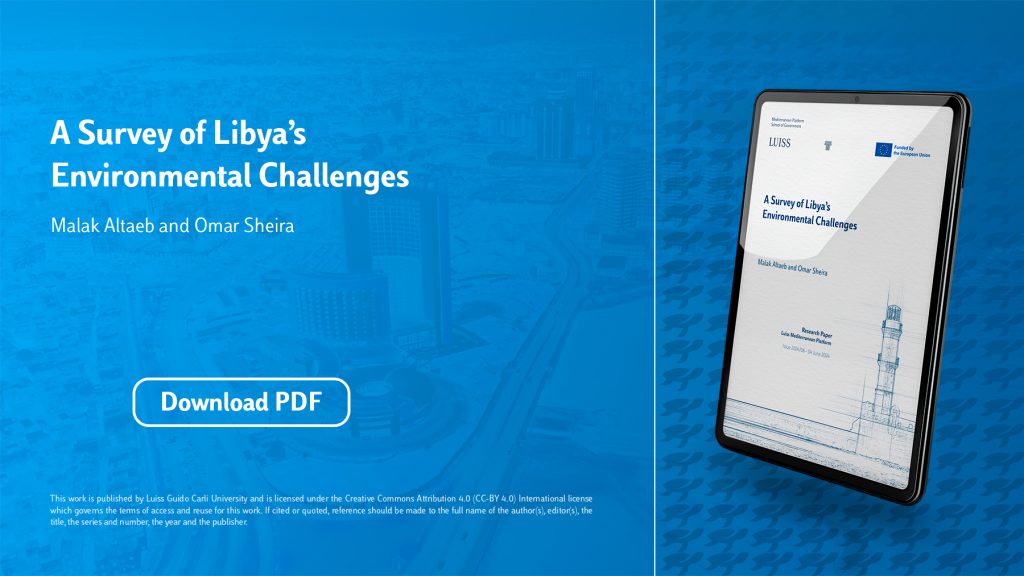Malak Altaeb and Omar Sheira 4 June, 2024
Executive Summary
Libya stands at a critical juncture. It faces a broad range of environmental challenges that threaten its livelihood, economy, and public health. These range from water scarcity and climate change to urbanisation, desertification, and pollution.
The country is facing a serious water crisis due to overconsumption, mismanagement, and negligence rather than water scarcity. Libya uses more groundwater than it can replenish and does not have enough rainfall to refill its renewable aquifers. Water access and quality vary significantly across Libyan cities and municipalities. While most areas are connected to the Great Man-Made River Project network, either legally or through unauthorised connections, many others are not. To cope, residents have relied on private wells, water tanks, rainfall, or a combination of these. The frequent electricity outages in recent years have also had a negative impact on water availability, as water access is dependent on electric pumps.
Water quality varies just as much as water access; some regions enjoy good quality water, others contend with salty water, and some face issues with poor quality water that is unsuitable for washing never mind consumption. In addition, the years of conflict have seen the water pipeline network compromised by vandalism, theft, and neglect. This has led to significant water loss and, in some cases, contamination. Without enough desalination and wastewater plants, Libya will struggle to sustain its current consumption.
Human activity and climate change have had major impacts on the environment. Human factors, such as conflict, urbanization, and desertification, have accelerated the loss of vegetation cover and farmland. Over the past decade, a general lack of security and oversight allowed the unregulated expansion of Libyan cities. As a result, the green belt surrounding Tripoli and Benghazi faced numerous building violations and encroachment upon green spaces across the country has become routine. In areas affected by the conflict, military attacks have left farms deserted and led to crop losses.
These issues are compounded by climate-induced threats. Higher temperatures, reduced rainfall, and water scarcity strain water resources. They contribute to a dramatic decrease in agricultural productivity. In response, some farmers have shifted from traditional – now unsustainable – farming methods, to more water-efficient irrigation techniques. Others, in the absence of government support, have abandoned their farms to seek better opportunities in cities with more reliable services. Interestingly, some areas around Tripoli and Benghazi have reported stable or even improved agricultural productivity. However, this phenomenon depends on excessive water extraction.
With eighty percent of Libya’s population concentrated in coastal cities, the rise in construction and vehicle use has made water, land, and air pollution a major concern. The country’s sewage system is outdated and overstretched, with frequent blocks, breakages, and overflows. Moreover, coastal cities discharge wastewater directly into the sea polluting the marine environment or they use ‘black wells’ (waste wells polluting the land).
Most cities struggle with poor waste management, with solid waste piling up in landfills and residential areas. Residents frequently burn waste to eliminate its stench and unsightly appearance. This increases air pollution and the risk of respiratory illnesses. The energy crisis of the past years has worsened matters. The widespread use of diesel-run electric generators has further reduced air quality in urban areas and intensified the impact of climate change. Natural phenomena like sand and dust storms are now more frequent and intense, due respectively to climate change and desertification. Both carry pollutants across vast distances, affecting agriculture, the economy, and public health.
Environmental and climate change awareness in Libya is generally low. Most Libyans have only a superficial understanding based on personal observation. Individuals, particularly those in rural areas, may have more direct experience with environmental changes. However, there is a general lack of in-depth awareness about climate change’s broader impacts and how human activities affect these issues. The absence of an environmental protection culture indicates that environmental concerns are generally not a priority for Libyan society or for the government. There is some recognition of climate change as a serious issue – especially following the Derna floods. However, the overall response has tended to be reactive and short-term. There is no comprehensive strategy.
In the absence of any government strategy, there have been attempts by local initiatives and individual efforts to respond to environmental challenges. These grassroots efforts aim to raise awareness on issues such as plastic and marine pollution, deforestation, decline in agriculture, and waste mismanagement. However, limited government support, restrictive laws, and financial constraints have hindered their impact on the ground. Local grassroots initiatives are usually short and lack coordination, making their long-term impact negligible. Their slow progress and weak focus, mainly appealing to the young, highlights the need for a more inclusive and broad-based form of engagement.
International organizations have focused their work in Libya on political issues, migration, female empowerment, and education. They have yet to focus on environmental issues. Future programs could support environmental awareness through educational programs and local media; raise awareness on storms and how to mitigate them; increase vegetation cover in Libya; and conduct research on the overall environmental situation and potential solutions.

